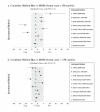Measurement of serum creatinine--current status and future goals
- PMID: 17581641
- PMCID: PMC1784008
Measurement of serum creatinine--current status and future goals
Abstract
The first methods for the measurement of creatinine in serum and plasma were published over a century ago. Today, the Jaffe reaction using alkaline picrate remains the cornerstone of most current routine methods, after continuous refinements attempting to overcome inherent analytical interferences and limitations. With the recent introduction of the reporting of estimated glomerular filtration rate (eGFR), inter-laboratory agreement of serum creatinine results has become an important international priority. Expert professional bodies have recommended that all creatinine methods should become traceable to a reference method based on isotope dilution-mass spectrometry (IDMS). It is important that clinical biochemists have a good understanding of the relative performance of routine creatinine methods. Using a new commutable IDMS-traceable reference material (SRM 967), and a validated tandem IDMS assay developed in our laboratory, we assessed the accuracy of nine routine creatinine methods with assistance from other laboratories in our region. Three methods appeared to have patient sample bias that exceeded 5% in the range of creatinine concentrations where eGFR estimations are most important. Companies are currently recalibrating their creatinine assays. This task should be complete in 2007, and then creatinine results for eGFR calculations will require the use of a modified eGFR equation. Laboratories considering calibration changes before this time can seek advice from the Australasian Creatinine Working Group.
Figures



References
-
- Behre JA, Benedict SR. Studies in creatine and creatinine metabolism. IV. On the question of the occurrence of creatinine and creatine in blood. J Biol Chem. 1922;52:11–33.
-
- National Kidney Foundation. K/DOQI clinical practice guidelines for chronic kidney disease: evaluation, classification and stratification. Kidney Disease Outcome Quality Initiative. Am J Kidney Dis. 2002;39:S1–S246. - PubMed
-
- Cockcroft DW, Gault MH. Prediction of creatinine clearance from serum creatinine. Nephron. 1976;16:31–41. - PubMed
-
- Levey AS, Bosch JP, Lewis JB, Green T, Rogers N, Roth D. A more accurate method to predict glomerular filtration rate from serum creatinine: a new prediction equation. Ann Int Med. 1999;130:461–70. - PubMed
-
- Myers GL, Miller WG, Coresh J, et al. Recommendations for improving serum creatinine measurement: A report from the Laboratory Working Group of the National Kidney Disease Education Program. Clin Chem. 2006;52:5–18. - PubMed
LinkOut - more resources
Full Text Sources
Other Literature Sources
Research Materials
Miscellaneous
